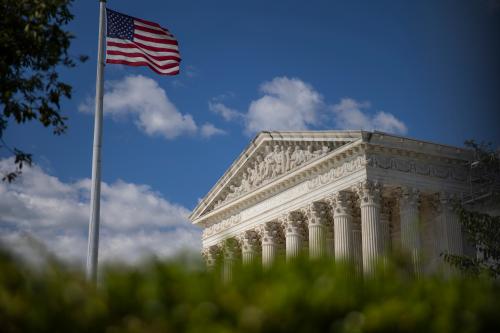Recently, the House and the Senate unanimously passed a resolution to reject white supremacy that was later signed by President Trump. In its condemnation of the overtly racist demonstrations in Charlottesville, Virginia, and the resulting deaths of counter-protestor Heather Heyer and two Virginia State police officers patrolling the protests by helicopter, the resolution calls upon the president and administration to denounce “…hate groups that espouse racism, extremism, xenophobia, anti-Semitism, and White supremacy.” The resolution also urges federal agencies, including the Departments of Justice and Homeland Security, to improve upon their data collection and investigation of hate crimes, and “address the growing prevalence of hate groups in the United States.”
In principle, this rare demonstration of bipartisanship sends a strong message repudiating the racist acts that occurred in August, especially amid the president’s lackluster and ambivalent response to the violence. The resolution also surfaces a more complicated question as to whether or not Congress can effectively legislate against white supremacy and racism in the 21st century.
Given the current administration’s steady reversals of civil rights and social justice policies, a resolution attempting to structure this president’s response to hate will most likely not be effective. It also remains to be seen if the racism observed in Charlottesville will trigger a national dialogue among starkly divided Americans.
Where legislation has attempted to right a wrong
Historically, white supremacist beliefs have influenced a myriad of mass efforts to perpetuate racial and ethnic oppression. The mid-Atlantic slave trade imported millions of Africans to the U.S. for forced and involuntary labor, leading to multi-generational servitude and wrongful deaths. Southern Jim Crow laws mandated the legal segregation of public facilities for whites and African Americans, supporting the belief in black inferiority. The disenfranchisement of African Americans at the ballot box was exercised through unfair political gerrymandering, physical intimidation, and deceptive financial penalties, from the Reconstruction period to the modern civil rights movement.
Immediately following the bombing in Pearl Harbor in 1941, more than 120,000 Japanese Americans were forced into relocation and incarceration in internment camps during World War II. During and after this time, Asian Americans were also openly victimized and ridiculed as a race amid the fear of another Asian invasion.
Hispanic Americans have long been the target of rigid immigration policies, subjecting them to unfair deportations, targeted bias and discrimination, and the denial of public services. According to a 2016 Pew study, more than half of Hispanic Americans reported experiencing discrimination or unfair treatment because of their race or ethnicity.
At various periods of time, federal legislation has attempted to exercise agency over these inequalities. The Emancipation Proclamation was signed by President Lincoln to free the slaves and indentured servants during the Civil War. In 1954, the Supreme Court struck down the constitutionality of “separate but equal” laws, ultimately initiating the dismantling of Jim Crow. President Johnson signed the Civil Rights Act of 1964, and later the Voting Rights Act of 1965 to ensure the equal access and opportunity for African Americans and other disenfranchised groups. Under the Civil Liberties Act of 1988 signed by President Reagan, more than 100,000 people of Japanese descent were compensated for their time spent incarcerated during World War II.
However, these and other federal remedies still return to the same premise shared in the early writings of sociologist W.E.B. DuBois that the “problem of the twentieth century is the color line.” And, this still is the case.
While the congressional resolution forcefully rejects hate groups and their vitriolic speech, these are symptoms—not causes—for the dilemma in which America finds herself. Unfortunately, the white supremacist beliefs exhibited in Charlottesville cannot be divorced from the general privilege historically afforded to white people more generally in this country.
Under Trump, white supremacists have also become even more insidious as they find a comfortable ally within an administration whose last nine months has included a steady roll back of civil rights policies and promises.
The lack of accountability in the current administration
There is a reason that Trump did not assert firm culpability after Charlottesville. Since his second day in office, racial and ethnic minorities have been intentionally dismissed, along with other Obama-era civil rights initiatives from the White House’s agenda. Trump’s DOJ rapidly began roll backs on criminal justice reform and mass incarceration by militarizing the police in underserved communities, re-privatizing prisons, and dismantling local consent decrees to combat police misconduct.
The DOJ is currently challenging affirmative action for “intentional race-based discrimination” in university admissions, despite being settled by the Supreme Court decision in the Fisher vs. University of Texas case.
An executive order establishing the Voter Elections Integrity Commission, led by a Secretary of State whose record of voter suppression is well documented, may be on the path toward tougher voter ID laws and other stringent requirements—further disenfranchising people of color.
Former Arizona Sheriff Joe Arpaio, who the federal courts found to racially profile and detain Hispanic immigrants, was pardoned by the president last month. A week later (prior to the signing of the congressional resolution), Trump and his administration called for the repeal of the Deferred Action for Childhood Arrivals (DACA) Act, which would allow the deportation of 800,000 individuals that Attorney General Jeff Sessions referred to as “illegal aliens” in a press conference.
And just recently, the president questioned the patriotism of black athletes as they exercise civil disobedience against racial inequality during the singing of the national anthem.
In hindsight, Congress would have better served the citizens through a wholesale rejection of leaders whose obvious indifference toward historically vulnerable groups runs counter to democratic values.
Do we need another Kerner Commission?
A new poll found that seven in 10 Americans view U.S. race relations as poor, especially in the aftermath of Charlottesville. Expressing the same disapproval, the chairman of the Congressional Black Caucus penned a letter stating his “utter disgust” for Trump’s “complete lack of understanding of or empathy for the very painful history and substantive policy concerns” affecting the African American community.
When President Johnson found himself in a similar situation in the 1960s, he commissioned the Kerner Report. Prior to the summer of 1967, 163 protests had erupted across the country over the mistreatment of African Americans by the police. The most pivotal ones taking place that year in Newark, New Jersey, and Detroit, Michigan. In response to the violent death of protestors and the excessive property damage in those communities, he established the 11-member National Advisory Commission on Civil Disorders (or, Kerner Commission), led by Illinois Governor Otto Kerner, Jr., to delve into the root causes for such dissension.
Some hailed the final report as a landmark moment in race relations, while others felt it did very little to effect change. Nonetheless, it facilitated a constructive discussion on race relations and the systemic variables contributing to inequality, most notably around the wealth gap, predatory lending and policing, disparate housing conditions, and unequal workforce and educational opportunities. The Kerner Report also gave some indication for how white supremacy and racism were playing out in the everyday lives of African Americans.
President Trump will probably never be as brave as Johnson. But, Congress can. Contemporary events should move them to establish a new bipartisan, federal commission that reasonably identifies the causes and related problems of 21st century race relations and racism, taking on hate speech as one of the many symptoms.
Author and poet James Baldwin wrote, “to accept one’s past—one’s history—is not the same thing as drowning in it. An invented past can never be used; it cracks and crumbles under the pressures of life like clay in a season of drought.” If Congress is interested in making real progress, perhaps they should start by acknowledging who and what America has become and expose those who desire to keep it that way.









Commentary
Can white supremacy be legislated under Trump?
October 4, 2017